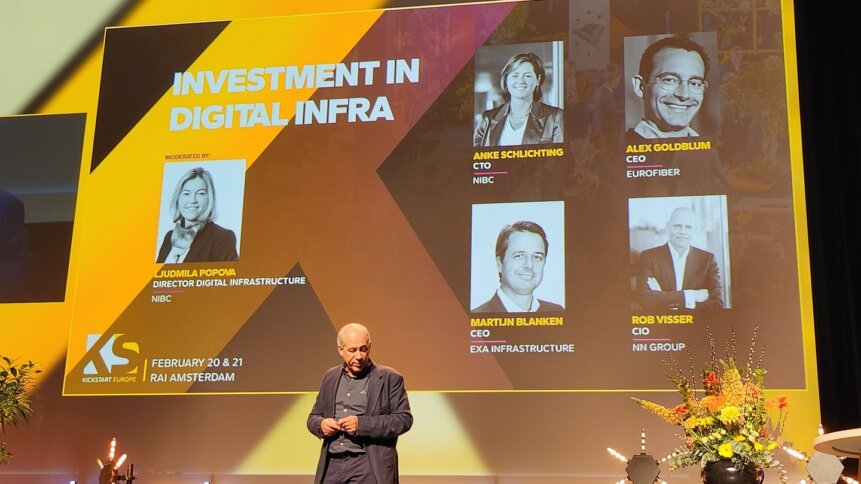Kickstart Europe – Investment in digital infrastructure

There are some truths you cannot escape, wherever in the world you go. One of those is that to make fundamental changes, you’re going to need investment. That’s why the first session at this year’s Kickstart Europe conference dealt with the issue of investment in digital infrastructure. But far from announcing a brow-clutching lack of funding for the digital infrastructure sector, the session focused on where the smart money should be going as we enter an economic year marked by significant opportunity – and significant challenges.
Run as a moderated panel discussion, it gathered four big players together and threw the crucial questions of the year at them, to illuminate the areas where investment in digital infrastructure would be crucial in 2023. Alex Goldblum, CEO of Eurofiber, Rob Visser, CIO of the NN Group, Anke Schlichting, CTO of NIBC (a leading bank with heavy interests in the sector), and Martijn Blanken, CEO of Exa Infrastructure, were all moderated by Ljudmila Popova, Director Digital Infrastructure at NIBC.
The keys to success
When asked about the keys to success in, for instance, providing 80 million customers with always-available service, 24/7, Rob Visser had a touchy-feely response. “People call me a CIO, a Chief Information Officer,” he said. “I see myself as a CPO – a Chief People Officer – because that’s the key. That’s the difference we make, it’s our people. So we invest heavily not only in technology, because all our products are digital these days, but also in what we call craftsmanship engineering. We all think our customers are obsessed with the latest technology, when really, what people want is for things to work. Reliably. Reliability and the ability to cope with the new innovations in technology – that’s the key for us as far as delivering massively on service.”
Anke Schlichting gave an Agatha Christie twist to her answer to the same question. “What people want is something that we happen to know is very complex… disguised as something that’s really simple. Easy interaction is key. It needs to be as easy as possible on the user-end, however complex we know it is behind the scenes.”
The challenge of hybrid working.
She expanded on her theme. “Take the hybrid working model. Working from anywhere is perfectly possible now, but it puts a strain on our industry. Years ago, if everybody in a company logged on at the same time, the system would crash. Now, after the pandemic and the shift in possibilities, we expect to be able to access our systems, wherever they are and wherever we are. Sounds easy, but it’s actually a very complex thing to do. Scarcity of resources has actually driven remote work into the foreground and built a global model.
That model contains challenges of connectivity for our industry, but it’s also driving the need for more data centers, and higher investment levels, because the model’s fundamentally built on that need and that expectation.”
Martijn Blanken echoed that point, and explained that the job of the data infrastructure industry, faced with this new model, was “to make sure that the infrastructure is not only available, but safe.”
And Alex Goldblum of Eurofiber, perhaps logically, focused on the connectivity challenges brought center stage by the new hybrid model. “Available, safe, high capacity and low latency,” he said. “That means there are lots of objects that need to be connected. And far from being a done deal, basic connectivity is not even a reality for half of the Netherlands. Our job is getting that infrastructure in place.” Asked whether the job was nearly done, he said “We’ve been doing it for 20 years. And we have as much to do again.”
Goldblum went further, explaining that “we’ve shifted from a technology and data perspective to a personal approach. We have some very manipulatable data models, and the use of data is something about which we have to be very careful.”
“Data has moved from being a novel driver of problem-solving to being normalized,” added Anke Schlichting. “We’re getting better data on how to solve problems than we’ve ever had before. And the thing about data is that we need it when we need it. That means flexible loads and competitive latencies are crucial for our business.”
When asked how reliable processing of the ever-increasing data mountain could be delivered efficiently, though, Schlichting was refreshingly blunt. “I don’t know…yet.” Speculating that those were questions which would probably be solved by companies working together, she acknowledged that flexibility was probably the way forward, before posing her own question. “How can we scale?”
Rob Visser jumped on that point. “This is the big thing. We’re investing a lot in scalability to make it work.” Alex Goldblum added that “the problem is not getting the data. The problem is getting access to, and then getting rid of the data.”
The challenges of 2023.
Asked to identify the major challenges facing investment in digital infrastructure today, the array of answers was instructive in much more than the different angles from which different parts of the sector are coming at the development of that infrastructure.
Martijn Blanken was first out of the gate. “Better digital security, while maintaining diversity and reliability,” he said, before adding “there are geopolitical issues too, with materials going through the Suez Canal. Solving those issues would serve the customers, while also being economically effective.”
Alex Goldblum added that adding deployment speed and breaking down some regulatory barriers would help the industry deliver more at a faster rate, to deal with the ever-increasing demand.
And, in the first real mention of what would become a theme across the Kickstart Europe conference in 2023, Blanken added that green energy infrastructure – and crucially, the funding for it – was not evenly distributed. It was a point well taken by the audience, and one that Anke Schlichting expanded.
“We’re all responsible for data security, too. We need more conversation on this, we need evidence and innovation on this – and on finding ways to help the planet, too.”
Squaring the circles of demand and ecology.
When it comes to investment in digital infrastructure in 2023, then, there’s a focus on delivery, on safety, on speed, and increasingly on dealing with the central conundrum of the digital infrastructure world.
That world exists to serve a growing and insatiable public and commercial need for the likes of cloud-based computing. That’s a need that’s grown to become a publicly understood necessity early in the 202s, as the business world survived a merciless pandemic by shifting its paradigm to a work-anywhere model that would have been unthinkable, let alone deliverable, just 50-10 years ago. But the world of digital infrastructure is also not deaf to the concerns of a public that feels an increasingly urgent need to embrace ecology before eve more extreme weather events wreak havoc on the way in which we live.
There may well be a concerted effort in 2023 to paint the digital infrastructure world as a highly necessary evil. But there will be significantly more effort dedicated to the question of how more investment in more digital infrastructure needn’t be an evil at all, and how far it can be effectively “greened” while still delivering the rate of service increase that both the public and the business community demand.










